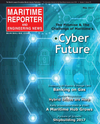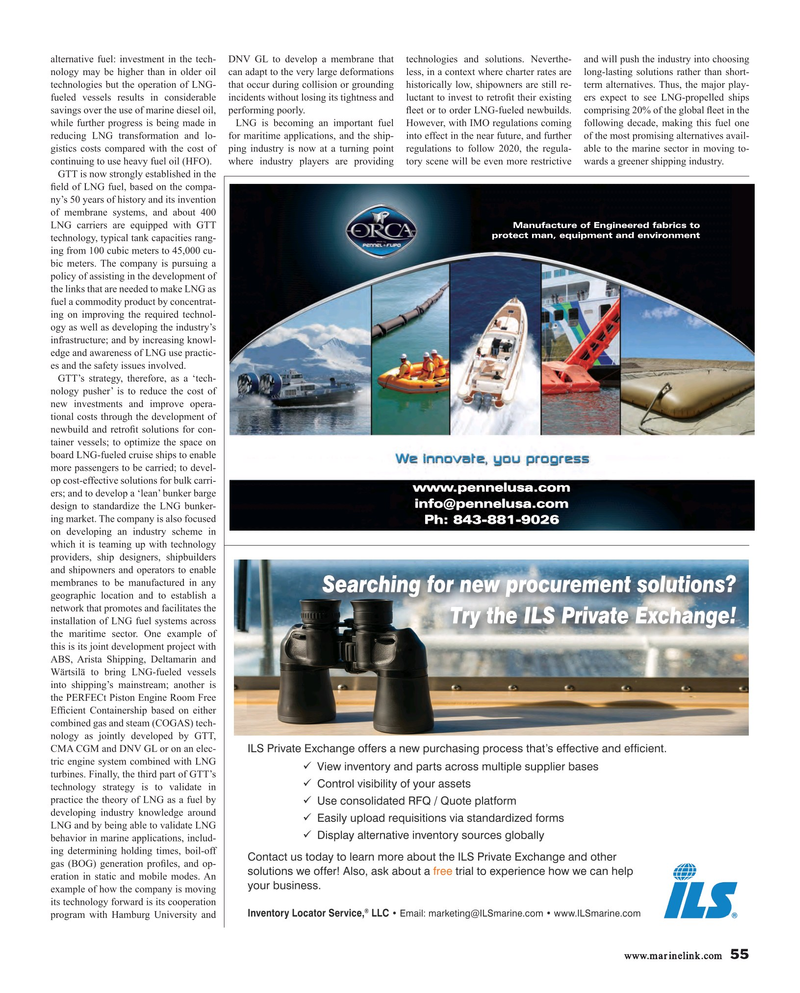
Page 55: of Maritime Reporter Magazine (May 2017)
The Marine Propulsion Edition
Read this page in Pdf, Flash or Html5 edition of May 2017 Maritime Reporter Magazine
alternative fuel: investment in the tech- DNV GL to develop a membrane that technologies and solutions. Neverthe- and will push the industry into choosing nology may be higher than in older oil can adapt to the very large deformations less, in a context where charter rates are long-lasting solutions rather than short- technologies but the operation of LNG- that occur during collision or grounding historically low, shipowners are still re- term alternatives. Thus, the major play- fueled vessels results in considerable incidents without losing its tightness and luctant to invest to retro? t their existing ers expect to see LNG-propelled ships savings over the use of marine diesel oil, performing poorly. ? eet or to order LNG-fueled newbuilds. comprising 20% of the global ? eet in the while further progress is being made in LNG is becoming an important fuel However, with IMO regulations coming following decade, making this fuel one reducing LNG transformation and lo- for maritime applications, and the ship- into effect in the near future, and further of the most promising alternatives avail- gistics costs compared with the cost of ping industry is now at a turning point regulations to follow 2020, the regula- able to the marine sector in moving to- continuing to use heavy fuel oil (HFO). where industry players are providing tory scene will be even more restrictive wards a greener shipping industry.
GTT is now strongly established in the ? eld of LNG fuel, based on the compa- ny’s 50 years of history and its invention of membrane systems, and about 400
Manufacture of Engineered fabrics to
LNG carriers are equipped with GTT protect man, equipment and environment technology, typical tank capacities rang- ing from 100 cubic meters to 45,000 cu- bic meters. The company is pursuing a policy of assisting in the development of the links that are needed to make LNG as fuel a commodity product by concentrat- ing on improving the required technol- ogy as well as developing the industry’s infrastructure; and by increasing knowl- edge and awareness of LNG use practic- es and the safety issues involved.
GTT’s strategy, therefore, as a ‘tech- nology pusher’ is to reduce the cost of new investments and improve opera- tional costs through the development of newbuild and retro? t solutions for con- tainer vessels; to optimize the space on board LNG-fueled cruise ships to enable more passengers to be carried; to devel- op cost-effective solutions for bulk carri- www.pennelusa.com ers; and to develop a ‘lean’ bunker barge [email protected] design to standardize the LNG bunker- ing market. The company is also focused
Ph: 843-881-9026 on developing an industry scheme in which it is teaming up with technology providers, ship designers, shipbuilders and shipowners and operators to enable membranes to be manufactured in any
Searching for new procurement solutions?
geographic location and to establish a network that promotes and facilitates the
Try the ILS Private Exchange!
installation of LNG fuel systems across the maritime sector. One example of this is its joint development project with
ABS, Arista Shipping, Deltamarin and
Wärtsilä to bring LNG-fueled vessels into shipping’s mainstream; another is the PERFECt Piston Engine Room Free
Ef? cient Containership based on either combined gas and steam (COGAS) tech- nology as jointly developed by GTT,
CMA CGM and DNV GL or on an elec- ,/63ULYDWH([FKDQJHRIIHUVDQHZSXUFKDVLQJSURFHVVWKDW·VHIIHFWLYHDQGHIÀFLHQW tric engine system combined with LNG 99LHZLQYHQWRU\DQGSDUWVDFURVVPXOWLSOHVXSSOLHUEDVHV turbines. Finally, the third part of GTT’s 9&RQWUROYLVLELOLW\RI\RXUDVVHWV technology strategy is to validate in practice the theory of LNG as a fuel by 98VHFRQVROLGDWHG5)44XRWHSODWIRUP developing industry knowledge around 9(DVLO\XSORDGUHTXLVLWLRQVYLDVWDQGDUGL]HGIRUPV
LNG and by being able to validate LNG 9'LVSOD\DOWHUQDWLYHLQYHQWRU\VRXUFHVJOREDOO\ behavior in marine applications, includ- ing determining holding times, boil-off &RQWDFWXVWRGD\WROHDUQPRUHDERXWWKH,/63ULYDWH([FKDQJHDQGRWKHU gas (BOG) generation pro? les, and op-
VROXWLRQVZHRIIHU$OVRDVNDERXWDIUHHWULDOWRH[SHULHQFHKRZZHFDQKHOS eration in static and mobile modes. An \RXUEXVLQHVV example of how the company is moving its technology forward is its cooperation ®
Inventory Locator Service, LLC?(PDLOPDUNHWLQJ#,/6PDULQHFRP?ZZZ,/6PDULQHFRP program with Hamburg University and www.marinelink.com 55
MR #5 (50-57).indd 55 MR #5 (50-57).indd 55 5/5/2017 1:38:59 PM5/5/2017 1:38:59 PM

 54
54

 56
56
